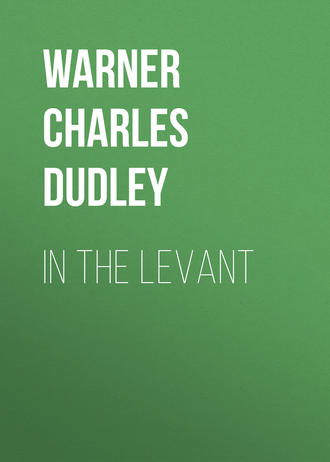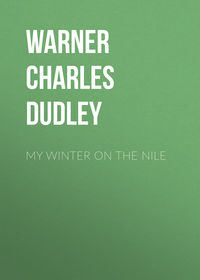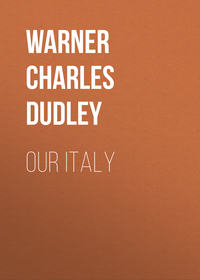 полная версия
полная версияIn The Levant
At the tomb we encountered a dozen students from the Latin convent, fine-looking fellows in long blue-black gowns, red caps, and red sashes. They sat upon the grass, on the brink of the excavation, stringing rosaries and singing student songs, with evident enjoyment of the hour’s freedom from the school; they not only made a picturesque appearance, but they impressed us also as a Jerusalem group which was neither sinful nor dirty. Beyond this tomb we noticed a handsome modern dwelling-house; you see others on various eminences outside the city, and we noted them as the most encouraging sign of prosperity about Jerusalem.
We returned over the hill and by the city wall, passing the Cave of Jeremiah and the door in the wall that opens into the stone quarries of Solomon. These quarries underlie a considerable portion of the city, and furnished the stone for its ancient buildings. I will not impose upon you a description of them; for it would be unfair to send you into disagreeable places that I did not explore myself.
The so-called Grotto of Jeremiah is a natural cavern in the rocky hill, vast in extent, I think thirty feet high and a hundred feet long by seventy broad,—as big as a church. The tradition is that Jeremiah lived and lamented here. In front of the cave are cut stones and pieces of polished columns built into walls and seats; these fragments seem to indicate the former existence here of a Roman temple. The cave is occupied by an old dervish, who has a house in a rock near by, and uses the cavern as a cool retreat and a stable for his donkey. His rocky home is shared by his wife and family. He said that it was better to live alone, apart from the world and its snares. He, however, finds the reputation of Jeremiah profitable, selling admission to the cave at a franc a head, and, judging by the women and children about him, he seemed to have family enough not to be lonely.
The sojourner in Jerusalem who does not care for antiquities can always entertain himself by a study of the pilgrims who throng the city at this season. We hear more of the pilgrimage to Mecca than of that to Jerusalem; but I think the latter is the more remarkable phenomenon of our modern life; I believe it equals the former, which is usually overrated, in numbers, and it certainly equals it in zeal and surpasses it in the variety of nationalities represented. The pilgrims of the cross increase yearly; to supply their wants, to minister to their credulity, to traffic on their faith, is the great business of the Holy City. Few, I imagine, who are not in Palestine in the spring, have any idea of the extent of this vast yearly movement of Christian people upon the Holy Land, or of the simple zeal which characterizes it. If it were in any way obstructed or hindered, we should have a repetition of the Crusades, on a vaster scale and gathered from a broader area than the wildest pilgrimage of the holy war. The driblets of travel from America and from Western Europe are as nothing in the crowds thronging to Jerusalem from Ethiopia to Siberia, from the Baltic to the Ural Mountains. Already for a year before the Easter season have they been on foot, slowly pushing their way across great steppes, through snows and over rivers, crossing deserts and traversing unfriendly countries; the old, the infirm, women as well as men, their faces set towards Jerusalem. No common curiosity moves this mass, from Ethiopia, from Egypt, from Russia, from European Turkey, from Asia Minor, from the banks of the Tagus and the Araxes; it is a true pilgrimage of faith, the one event in a life of dull monotony and sordid cares, the one ecstasy of poetry in an existence of poverty and ignorance.
We spent a morning in the Russian Hospice, which occupies the hill to the northwest of the city. It is a fine pile of buildings, the most conspicuous of which, on account of its dome, is the church, a large edifice with a showy exterior, but of no great merit or interest. We were shown some holy pictures which are set in frames incrusted with diamonds, emeralds, rubies, and other precious gems, the offerings of rich devotees, and displaying their wealth rather than their taste.
The establishment has one building for the accommodation of rich pilgrims, and a larger one set apart for peasants. The hospice lodges, free of charge, all the Russian pilgrims. The exterior court was full of them. They were sunning themselves, but not inclined to lay aside their hot furs and heavy woollens. We passed into the interior, entering room after room occupied by the pilgrims, who regarded our intrusion with good-natured indifference, or frankly returned our curiosity. Some of the rooms were large, furnished with broad divans about the sides, which served for beds and lounging-places, and were occupied by both sexes. The women, rosy-cheeked, light-haired, broad, honest-looking creatures, were mending their clothes; the men were snoozing on the divans, flat on their backs, presenting to the spectator the bottoms of their monstrous shoes, which had soles eight inches broad; a side of leather would be needed for a pair. In these not very savory rooms they cook, eat, and sleep. Here stood their stoves; here hung their pilgrim knapsacks; here were their kits of shoemaker’s tools, for mending their foot-gear, which they had tugged thousands of miles; here were household effects that made their march appear more like an emigration than a pilgrimage; here were the staring pictures of St. George and the Dragon, and of other saints, the beads and the other relics, which they had bought in Jerusalem.
Although all these pilgrims owed allegiance to the Czar, they represented a considerable variety of races. They came from Archangel, from Tobolsk, from the banks of the Ural, from Kurland; they had found their way along the Danube, the Dnieper, the Don. I spoke with a group of men and women who had walked over two thousand miles before they reached Odessa and took ship for Jaffa. There were among them Cossacks, wild and untidy, light-haired barbarians from the Caucasus, dark-skinned men and women from Moscow, representatives from the remotest provinces of great Russia; for the most part simple, rude, clumsy, honest boors. In an interior court we found men and women seated on the sunny flagging, busily occupied in arranging and packing the souvenirs of their visit. There was rosemary spread out to dry; there were little round cakes of blessed bread stamped with the image of the Saviour; there were branches of palm, crowns of thorns, and stalks of cane cut at the Jordan; there were tin cases of Jordan water; there were long strips of cotton cloth stamped in black with various insignia of death, to serve at home for coffin-covers; there were skull-caps in red, yellow, and white, also stamped with holy images, to be put on the heads of the dead. I could not but in mind follow these people to their distant homes, and think of the pride with which they would show these trophies of their pilgrimage; how the rude neighbors would handle with awe a stick cut on the banks of the Jordan, or eat with faith a bit of the holy bread. How sacred, in those homes of frost and snow, will not these mementos of a land of sun, of a land so sacred, become! I can see the wooden chest in the cabin where the rosemary will be treasured, keeping sweet, against the day of need, the caps and the shrouds.
These people will need to make a good many more pilgrimages, and perhaps to quit their morose land altogether, before they can fairly rank among the civilized of the earth. They were thickset, padded-legged, short-bodied, unintelligent. The faces of many of them were worn, as if storm-beaten, and some kept their eyes half closed, as if they were long used to face the sleet and blasts of winter; and I noticed that it gave their faces a very different expression from that produced by the habit the Egyptians have of drawing the eyelids close together on account of the glare of the sun.
We took donkeys one lovely morning, and rode from the Jaffa Gate around the walls on our way to the Mount of Olives. The Jerusalem donkey is a good enough donkey, but he won’t go. He is ridden with a halter, and never so elegantly caparisoned as his more genteel brother in Cairo. In order to get him along at all, it needs one man to pull the halter and another to follow behind with a stick; the donkey then moves by inches,—if he is in the humor. The animal that I rode stopped at once, when he perceived that his driver was absent. No persuasions of mine, such as kicks and whacks of a heavy stick, could move him on; he would turn out of the road, put his head against the wall, and pretend to go to sleep. You would not suppose it possible for a beast to exhibit so much contempt for a man.
On the high ground outside the wall were pitched the tents of travellers, making a very pretty effect amid the olive-trees and the gray rocks. Now and then an Arab horseman came charging down the road, or a Turkish official cantered by; women, veiled, clad in white balloon robes that covered them from head to foot, flitted along in the sunshine, mere white appearances of women, to whom it was impossible to attribute any such errand as going to market; they seemed always to be going to or returning from the cemetery.
Our way lay down the rough path and the winding road to the bottom of the Valley of Jehoshaphat. Leaving the Garden of Gethsemane on our right, we climbed up the rugged, stony, steep path to the summit of the hill. There are a few olive-trees on the way, enough to hinder the view where the stone-walls would permit us to see anything; importunate begging Moslems beset us; all along the route we encountered shabbiness and squalor. The rural sweetness and peace that we associate with this dear mount appear to have been worn away centuries ago. We did not expect too much, but we were not prepared for such a shabby show-place. If we could sweep away all the filthy habitations and hideous buildings on the hill, and leave it to nature, or, indeed, convert the surface into a well-ordered garden, the spot would be one of the most attractive in the world.
We hoped that when we reached the summit we should come into an open, green, and shady place, free from the disagreeable presence of human greed and all the artificiality that interposed itself between us and the sentiment of the place. But the traveller need not expect that in Palestine. Everything is staked out and made a show of. Arrived at the summit, we could see little or nothing; it is crowned with the dilapidated Chapel of the Ascension. We entered a dirty court, where the custodian and his family and his animals live, and from thence were admitted to the church. In the pavement is shown the footprint of our ascending Lord, although the Ascension was made at Bethany. We paid the custodian for permission to see this manufactured scene of the Ascension. The best point of view to be had here is the old tower of the deserted convent, or the narrow passage to it on the wall, or the top of the minaret near the church. There is no place on wall or tower where one can sit; there is no place anywhere here to sit down, and in peace and quiet enjoy the magnificent prospect, and meditate on the most momentous event in human history. We snatched the view in the midst of annoyances. The most minute features of it are known to every one who reads. The portion of it I did not seem to have been long familiar with is that to the east, comprising the Jordan valley, the mountains of Moab, and the Dead Sea.
Although this mount is consecrated by the frequent presence of Christ, who so often crossed it in going to and from Bethany, and retired here to meditate and to commune with his loved followers, everything that the traveller at present encounters on its summit is out of sympathy with his memory. We escaped from the beggars and the showmen, climbed some stone-walls, and in a rough field near the brow of the hill, in a position neither comfortable nor private, but the best that we found, read the chief events in the life of Christ connected with this mount, the triumphal entry, and the last scenes transacted on yonder hill. And we endeavored to make the divine man live again, who so often and so sorrowfully regarded the then shining city of Zion from this height.
To the south of the church and a little down the hill is the so-called site of the giving of the Lord’s Prayer. I do not know on what authority it is thus named. A chapel is built to mark the spot, and a considerable space is enclosed before it, in which are other objects of interest, and these were shown to us by a pleasant-spoken lady, who is connected with the convent, and has faith equal to the demands of her position. We first entered a subterranean vaulted room, with twelve rough half-pillars on each side, called the room where the Apostles composed the creed. We then passed into the chapel. Upon the four walls of its arcade is written, in great characters, the Lord’s Prayer in thirty-two languages; among them the “Canadian.”
In a little side chapel is the tomb of Aurelia de Bossa, Princesse de la Tour d’.uvergne, Duchesse de Bouillon, the lady whose munificence established this chapel and executed the prayer in so many tongues. Upon the side of the tomb this fact of her benevolence is announced, and the expectation is also expressed, in French, that “God will overwhelm her with blessing for ever and ever for her good deed.” Stretched upon the sarcophagus is a beautiful marble effigy of the princess; the figure is lovely, the face is sweet and seraphic, and it is a perfect likeness of her ladyship.
I do not speak at random. I happen to know that it is a perfect likeness, for a few minutes after I saw it, I met her in the corridor, in a semi-nunlike costume, with a heavy cross hanging by a long gold chain at her side. About her forehead was bound a barbarous frontlet composed of some two hundred gold coins, and ornaments not unlike those worn by the ladies of the ancient Egyptians. This incongruity of costume made me hesitate whether to recognize in this dazzling vision of womanhood a priestess of Astarte or of Christ. At the farther door, Aurelia de Bossa, Princesse de la Tour d’.uvergne, Duchesse de Bouillon, stopped and blew shrilly a silver whistle which hung at her girdle, to call her straying poodle, or to summon a servant. In the rear of the chapel this lady lives in a very pretty house, and near it she was building a convent for Carmelite nuns. I cannot but regard her as the most fortunate of her sex. She enjoys not only this life, but, at the same time, all the posthumous reputation that a lovely tomb and a record of her munificence engraved thereon can give. We sometimes hear of, but we seldom see, a person, in these degenerate days, living in this world as if already in the other.
We went on over the hill to Bethany; we had climbed up by the path on which David fled from Absalom, and we were to return by the road of the Triumphal Entry. All along the ridge we enjoyed a magnificent panorama: a blue piece of the Dead Sea, the Jordan plain extending far up towards Herraon with the green ribbon of the river winding through it, and the long, even range of the Moab hills, blue in the distance. The prospect was almost Swiss in its character, but it is a mass of bare hills, with scarcely a tree except in the immediate foreground, and so naked and desolate as to make the heart ache; it would be entirely desolate but for the deep blue of the sky and an atmosphere that bathes all the great sweep of peaks and plains in color.
Bethany is a squalid hamlet clinging to the rocky hillside, with only one redeeming feature about it,—the prospect. A few wretched one-story huts of stone, and a miserable handful of Moslems, occupy this favorite home and resting-place of our Lord. Close at hand, by the roadside, cut in the rock and reached by a steep descent of twenty-six steps, is the damp and doubtful tomb of Lazarus, down into which any one may go for half a franc paid to the Moslem guardian. The house of Mary and Martha is exhibited among the big rocks and fragments of walls; upon older foundations loose walls are laid, rudely and recently patched up with cut stones in fragments, and pieces of Roman columns. The house of Simon the leper, overlooking the whole, is a mere heap of ruins. It does not matter, however, that all these dwellings are modern; this is Bethany, and when we get away from its present wretchedness we remember only that we have seen the very place that Christ loved.
We returned along the highway of the Entry slowly, pausing to identify the points of that memorable progress, up to the crest where Jerusalem broke upon the sight of the Lord, and whence the procession, coming round the curve of the hill, would have the full view of the city. He who rides that way to-day has a grand prospect. One finds Jerusalem most poetic when seen from Olivet, and Olivet most lovely when seen from the distance of the city walls.
At the foot of the descent we turned and entered the enclosure of the Garden of Gethsemane. Three stone-wall enclosures here claim to be the real garden; one is owned by the Greeks, another by the Armenians, the third by the Latins. We chose the last, as it is the largest and pleasantest; perhaps the garden, which was certainly in this vicinity, once included them all. After some delay we were admitted by a small door in the wall, and taken charge of by a Latin monk, whose young and sweet face was not out of sympathy with the place. The garden contains a few aged olive-trees, and some small plots of earth, fenced about and secured by locked gates, in which flowers grow. The guardian gave us some falling roses, and did what he could to relieve the scene of its artificial appearance; around the wall, inside, are the twelve stations of the Passion, in the usual tawdry style.
But the birds sang sweetly in the garden, the flowers of spring were blooming, and, hemmed in by the high wall, we had some moments of solemn peace, broken only by the sound of a Moslem darabooka drum throbbing near at hand. Desecrated as this spot is, and made cheap by the petty creations of superstition, one cannot but feel the awful significance of the place, and the weight of history crowding upon him, where battles raged for a thousand years, and where the greatest victory of all was won when Christ commanded Peter to put up his sword. Near here Titus formed his columns which stormed the walls and captured the heroic city after its houses, and all this valley itself, were filled with Jewish dead; but all this is as nothing to the event of that awful night when the servants of the high-priest led away the unresisting Lord.
It is this event, and not any other, that puts an immeasurable gulf between this and all other cities, and perhaps this difference is more felt the farther one is from Jerusalem. The visitor expects too much; he is unreasonably impatient of the contrast between the mean appearance of the theatre and the great events that have been enacted on it; perhaps he is not prepared for the ignorance, the cupidity, the credulity, the audacious impostures under Christian names, on the spot where Christianity was born.
When one has exhausted the stock sights of Jerusalem, it is probably the dullest, least entertaining city of the Orient; I mean, in itself, for its pilgrims and its religious fêtes, in the spring of the year, offer always some novelties to the sight-seer; and, besides, there is a certain melancholy pleasure to be derived from roaming about outside the walls, enveloped in a historic illusion that colors and clothes the nakedness of the landscape.
The chief business of the city and the region seems to be the manufacture of religious playthings for the large children who come here. If there is any factory of relics here I did not see it. Nor do I know whether the true cross has still the power of growing, which it had in the fourth century, to renew itself under the constant demand for pieces of it. I did not go to see the place where the tree grew of which it was made; the exact spot is shown in a Greek convent about a mile and a half west of the city. The tree is said to have been planted by Abraham and Noah. This is evidently an error; it may have been planted by Adam and watered by Noah.
There is not much trade in antiquities in the city; the shops offer little to tempt the curiosity-hunter. Copper coins of the Roman period abound, and are constantly turned up in the fields outside the city, most of them battered and defaced beyond recognition. Jewish mites are plenty enough, but the silver shekel would be rare if the ingenious Jews did not keep counterfeits on hand. The tourist is waited on at his hotel by a few patient and sleek sharks with cases of cheap jewelry and doubtful antiques, and if he seeks the shops of the gold and silver bazaars he will find little more. I will not say that he will not now and then pick up a piece of old pottery that has made the journey from Central Asia, or chance upon a singular stone with a talismanic inscription. The hope that he may do so carries the traveller through a great many Eastern slums. The chief shops, however, are those of trinkets manufactured for the pilgrims, of olive-wood, ivory, bone, camels’ teeth, and all manner of nuts and seeds. There are more than fifty sorts of beads, strung for profane use or arranged for rosaries, and some of them have pathetic names, like “Job’s tears.” Jerusalem is entitled to be called the City of Beads.
There is considerable activity in Jewish objects that are old and rather unclean; and I think I discovered something like an attempt to make a “corner” in phylacteries, that is, in old ones, for the new are made in excess of the demand. If a person desires to carry home a phylactery to exhibit to his Sunday school, in illustration of the religion of the Jews, he wants one that has been a long time in use. I do not suppose it possible that the education of any other person is as deficient as mine was in the matter of these ornamental aids in worship. But if there is one, this description is for him: the phylactery, common size, is a leathern box about an inch and a half square, with two narrow straps of leather, about three feet long, sewed to the bottom corners. The box contains a parchment roll of sacred writing. When the worshipper performs his devotions in the synagogue, he binds one of the phylacteries about his left arm and the other about his head, so that the little box has something of the appearance of a leathern horn sprouting out of his forehead. Phylacteries are worn only in the synagogue, and in this respect differ from the greasy leathern talismans of the Nubians, which contain scraps from the Koran, and are never taken off. Whatever significance the phylactery once had to the Jew it seems now to have lost, since he is willing to make it an article of merchandise. Perhaps it is poverty that compels him also to sell his ancient scriptures; parchment rolls of favorite books, such as Esther, that are some centuries old, are occasionally to be bought, and new rolls, deceitfully doctored into an appearance of antiquity, are offered freely.
A few years ago the antiquarian world was put into a ferment by what was called the “Shoepira collection,” a large quantity of clay pottery,—gods, votive offerings, images, jars, and other vessels,—with inscriptions in unknown characters, which was said to have been dug up in the land of Moab, beyond the Jordan, and was expected to throw great light upon certain passages of Jewish history, and especially upon the religion of the heathen who occupied Palestine at the time of the conquest. The collection was sent to Berlin; some eminent German savans pronounced it genuine; nearly all the English scholars branded it as an impudent imposture. Two collections of the articles have been sent to Berlin, where they are stored out of sight of the public generally, and Mr. Shoepira has made a third collection, which he still retains.
Mr. Shoepira is a Hebrew antiquarian and bookseller, of somewhat eccentric manners, but an enthusiast. He makes the impression of a man who believes in his discoveries, and it is generally thought in Jerusalem that if his collection is a forgery, he himself is imposed on. The account which he gives of the places where the images and utensils were found is anything but clear or definite. We are required to believe that they have been dug up in caves at night and by stealth, and at the peril of the lives of the discoverers, and that it is not safe to visit these caves in the daytime on account of the Bedaween. The fresh-baked appearance of some of the articles is admitted, and it is said that it was necessary to roast them to prevent their crumbling when exposed to the air. Our theory in regard to these singular objects is that a few of those first shown were actually discovered, and that all the remainder have been made in imitation of them. Of the characters (or alphabet) of the inscriptions, Mr. Schepira says he has determined twenty-three; sixteen of these are Phoenician, and the others, his critics say, are meaningless. All the objects are exceedingly rude and devoid of the slightest art; the images are many of them indecent; the jars are clumsy in shape, but the inscriptions are put on with some skill. The figures are supposed to have been votive offerings, and the jars either memorial or sepulchral urns.





